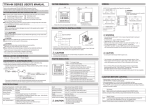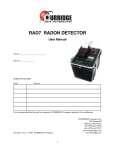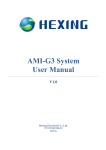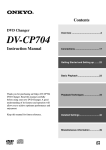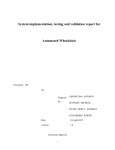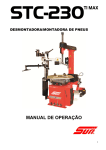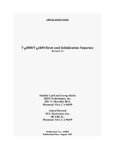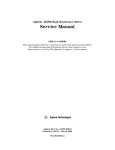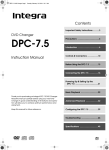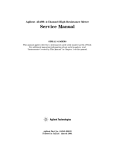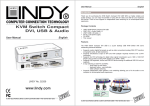Download TTM-i4N SERIES INSTALLATION MANUAL DIGITAL
Transcript
Digital Controller TTM‐i4N User’s Manual Contents 1. Precautions upon Usage 2 2. Name and Function of Parts 4 3. Installation 5 3.1 Dimensions 3.2 Installation and Dimensions of Panel Cut 5 5 4. Wiring 6 4.1 Terminal Layout for Wiring 4.2 Caution upon Wiring 6 6 5. List of 7-segment Characters 7 6. Operation Flow and Parameters 8 6.1 Display Sections 6.2 Operation Keys 6.3 Operation Flow 6.4 Parameters 6.5 Other Displays 8 9 9 21 69 7. List of Models 70 8. Before Performing a Control 71 9. Specifications 72 9.1 General Specifications 9.2 Rated Values and Performance 72 73 10. Maintenance and Inspection 1 74 1. Precautions upon Usage Please read this section before use. For the safe use of this product, please take note of the following: This operation manual should be kept by the user of this product. ★Safety Precautions For the safe use of the product and to prevent possible accident or damage, the following warning signs are used in this operation manual depending on their level of importance and risk. Please follow each instruction in order for you to use the product safely. ★Warning Symbols and Their Meanings Danger Improper handling of the equipment may cause fatality or serious injury for an impending reality. Caution Improper handling of the equipment may cause injury or physical damage on it. Warning Improper handling of the equipment may cause fatality or serious injury. Reminder Care should be taken for ensuring safety. Matters that are indicated as “Caution” can also turn into serious accidents, depending on the situation. Please follow all instructions described herein for the safe use of this product. ★Example of Symbols General caution, warning or prohibition without particularity Instruction on ground connection for the equipment with safety grounding terminals Hazard of pinched fingers on a particular portion of the equipment Possible injury caused by touching a particular portion of the equipment under specific conditions Unspecific behaviors of general users Hazard of injury due to high temperature under specific conditions Hazard of an electric shock under specific conditions Hazard of injury such as an electric shock due to disassembling or modification of the equipment Hazard of burst under particular conditions 2 Warning Improper wiring to the equipment may cause a failure, such as fire. Upon completion of wiring, ensure to verify the proper wiring before turning on electricity. Do not turn on electricity until all wiring is complete. Do not touch portions of high voltages such as power supply terminals, as an electric shock may be resultant. Install appropriate protective circuits externally if a failure or abnormality of the equipment may seriously affect related systems. Do not use the equipment out of the specified range, as it may fail or catch fire. Do not under any circumstance to modify or disassemble the equipment, as a failure may be caused, resulting fire or an electric shock. Do not use the equipment in ambience of flammable or explosive gases. Caution Do not use the vacant terminals for wiring. Do not use a pointed object to operate keys. Do not turn on the power supply until wiring is fully complete in order to prevent an electric shock, failure or malfunctioning. For replacing a component connected on the equipment, ensure to turn off the power supply. For turning back on the power supply, do so after all wiring is complete. Ensure not to trap heat in the space surrounding the equipment in order to provide sufficient heat release. Do not put a metal piece or similar inside the equipment. A fire, an electric shock or failure may be caused. The equipment is designed for instrumentation. For its use in environments of high voltages or intense noises, take appropriate measures on the side of user’s equipment. The equipment is designed for controlling physical values, such as temperatures, on general industrial facilities. Do not use it for subjects of control that may seriously affect human life. Turn off the power supply before cleaning the equipment, and wipe it with a soft dry cloth. Do not use thinners, as they may cause deformation or discoloration of the equipment. The equipment may cause radio disturbances in domestic settings. User is required to take appropriate measure. Ensure to tighten terminal screws at specified torque. Insufficient tightening the screws may cause an electric shock or fire. Ensure to observe precautions listed in this manual for the use of the equipment. Reprinting or duplicating this manual is prohibited. This manual may be revised without prior notice. Important Reminder Regarding Export Trade Control Order Please investigate the client and the purpose of his or her usage to make sure that the product will not be used as a weapon of mass destruction (e.g., for military purposes and use in military facilities). 3 2. Name and Function of Parts PV SV °F °C RDY OUT AL1 AL2 M Key F Key ▲▼keys Displays the character of current measurement value or setting mode screen. Displays the selected input value of setting value, output value, or setting mode screen. Lights up when the setting value is a temperature data with the unit of °F. Lights up when the setting value is a temperature data with the unit of °C. Lights up when the control mode is RDY (ready). Lights up when OUT1 (Output 1) is turned ON. Lights up when Event Output 1 is turned ON. Lights up when Event Output 2 is turned ON. If heat/cool control is selected, it also lights up when OUT2 is turned ON. Switches screens. Executes functions that are being set. Increases or decreases (to change) the setting value. (Pressing each key continuously will increase/decrease the value more quickly.) 4 3. Installation 3.1 Dimensions 3.2 Installation and Dimensions of Panel Cut Attach the product either vertically (upper surface of the product should be facing up) or horizontally. How to Attach: Place the product into an angle hole of the panel cut and completely insert the attachment from the surface without any gap. 5 4. Wiring 4.1 Terminal Layout for Wiring 4.2 Caution upon Wiring Warning: Turn the power OFF before wiring to avoid the risk of electric shock. Caution:This product will not perform any control for approximately 4 seconds after turning its power ON (produces no output).Please be careful if you will be using this product as an interlock circuit. ・Check the wiring with the operation manual to make sure that input terminal, power terminal, option terminal, and other such terminals are connected correctly. ・ Upon wiring, use the crimped terminal that fits with the M3.5 screw (squeeze the wire into the center of the terminal). ・For the connection between the resistance temperature detector and the product, use the wire with the resistance of less than 5Ω (per wire). ・For the connection between the thermocouple and the product, use the prescribed compensating lead wire or the wire itself. ・ Use the radio shield wire if the product is to be used near the noise source. Do not wire the input-output line in the same duct or conduit tube. ・Separate the input-output signal line from both power and load lines with the distance of at least 50cm. ・ Do not connect anything to the blank terminal. 6 5. List of 7-segment Characters < List of 7-segment Characters > Numbers and alphabets used in parameter symbols and settings are described as follows: 0 1 2 3 4 5 6 7 8 9 A B C D E F G H I J K L M N O P Q R S T U V W X Y Z − Blank 7 6. Operation Flow and Parameters 6.1 Display Sections Display Sections PV Display Section Color White Description • Displays measurement values and characters that have been set. SV Display Section Green • Displays setting values and manipulated variables. °F Yellow • Lights up when the setting value is a temperature data with the unit of °F. °C Yellow • Lights up when the setting value is a temperature data with the unit of °C. RDY Display Yellow • Lights up when the control mode is RDY. OUT Display Yellow • Lights up when OUT1 is turned ON. AL1 Display Yellow • Lights up when Event 1 Output is turned ON. AL2 Display Yellow • Lights up when Event 2 Output is turned ON. If heat/cool control is selected, it also lights up when OUT2 is turned ON. 8 6.2 Operation Keys Operation Keys M Key F Key DOWN Key UP Key Description • Switches screens. • Executes functions that are being set. 1) Digit Navigation Key (selected digit blinks): Usable in all modes. 2) RUN/READY Key: Usable only in operation mode. Click once to enable the function. 3) AT Start/Stop Key: Usable only in operation mode. Click once to enable the function. 4) Timer Start/Reset Key: Usable only in operation mode. Click once to enable the function. 5) Alarm Reset Key: Usable only in operation mode. Click once to enable the function. 6) ENTER Key: Usable in all modes. • Decreases the setting value. (Pressed consecutively for 0.5–5secs.: 1 digit/100msecs.) (Pressed consecutively for 5–10secs.: 10 digits/100msecs.) (Pressed consecutively for more than 10secs.: 100 digits/100msecs.) • Increases the setting value. (Pressed consecutively for 0.5–5secs.: 1 digit/100msecs.) (Pressed consecutively for 5–10secs.: 10 digits/100msecs.) (Pressed consecutively for more than 10secs.: 100 digits/100msecs.) 6.3 Operation Flow 9 6.3.1 Operation Mode PV SV PV SV PV SV PV SV PV SV PV SV PV SV PV SV PV SV PV SV 1200 1. Controlled Temperature Setting 0 ↓M Key **** 2. Priority Screen 1 **** ↓M Key **** 3. Priority Screen 2 **** ↓M Key **** 4. Priority Screen 3 **** ↓M Key **** 5. Priority Screen 4 **** ↓M Key **** 6. Priority Screen 5 **** ↓M Key **** 7. Priority Screen 6 **** ↓M Key **** 8. Priority Screen 7 **** ↓M Key **** 9. Priority Screen 8 **** ↓M Key **** 10. Priority Screen 9 **** ↓M Key Back to 1. 10 6.3.2 Protect Setting Mode PV SV PTLV 0 1. Protect Level Setting 6.3.3 Priority Screen Parameter Mode PV SV PV SV PV SV PV SV PV SV PV SV PV SV PV SV PV SV PV SV SET0 PRI 1. Setting Mode Selection Screen ↓M Key PRI1 2. Priority screen 1 setting OFF ↓M Key PRI2 3. Priority screen 2 setting OFF ↓M Key PRI3 4. Priority screen 3 setting OFF ↓M Key PRI4 5. Priority screen 4 setting OFF ↓M Key PRI5 6. Priority screen 5 setting OFF ↓M Key PRI6 7. Priority screen 6 setting OFF ↓M Key PRI7 8. Priority screen 7 setting OFF ↓M Key PRI8 9. Priority screen 8 setting OFF ↓M Key PRI9 10. Priority screen 9 setting OFF ↓M Key Back to 1. 11 6.3.4 Input Parameter Mode PV SV PV SV PV SV PV SV PV SV PV SV PV SV SET1 INP 1. Setting Mode Selection Screen ↓M Key INP 2. Input type setting 00 ↓M Key PVG 3. PV compensation gain setting 100 ↓M Key PVS 4. PV compensation zero setting 0 ↓M Key PDF 5. Setting of Input Filter 00 ↓M Key DP 6. Decimal point setting 0 ↓M Key C/F 7. Temperature unit setting *C ↓M Key Back to 1. 12 6.3.5 Key Function Parameter Mode PV SV PV SV PV SV PV SV SET2 KEY 1. Setting Mode Selection Screen ↓M Key FU 2. Function key function setting 00 ↓M Key LOC 3. Key-lock setting 0 ↓M Key ALRS 4. Alarm reset 0 0 ↓M Key Back to 1. 13 6.3.6 Control Parameter Mode PV SV PV SV PV SV PV SV PV SV PV SV PV SV SET3 CNT 1. Setting Mode Selection Screen ↓M Key SLH 2. SV limiter upper limit 1200 ↓M Key SLL 3. SSV limiter lower limit 0 ↓M Key MD 4. Control mode setting RUN ↓M Key CNT 5. Control type setting 020 ↓M Key DIR 6. Tuning type setting 0 ↓M Key MV1 7. Manipulated Variable of Output 1 00 M key PV SV PV SV PV SV PV SV PV SV PV SV TUN 1 8. Setting of Tuning Type ※1 ↓M Key ATG 9. AT coefficient setting ※1 10 PV SV C1 1 19. Sensitivity setting for OUT1※2 ↓M Key PV SV ↓M Key ATC 10. AT sensitivity setting ※1 CP1 0 M Key 2 ↓M Key AT 11. AT start/stop ※1 OFF ↓M Key P1 12. Proportional band setting for OUT1 ※1 30 ↓M Key I 13. Integral time setting ※1 0 ↓M Key 14 20. OFF point position setting for OUT1※2 ↓ PV SV PV SV PV SV PV SV PV SV D 0 14. Derivative time setting ※1 ↓M Key T1 15. Proportional cycle setting for OUT1 ※1 20 ↓M Key ARW 16. Setting of Anti-reset Windup ※1 1100 ↓M Key MLH1 17. Operating amout limiter upper limit for OUT1 ※1 1000 ↓M Key MLL1 18. Operating amout limiter lower limit for OUT1 ※1 00 M key PV SV PV SV PV SV PV SV PV SV PV SV LOP1 0 21. Setting of the Loop Abnormality Judgment Time of Output 1 ↓M Key PS1 22. Setting of the Loop Abnormality PV Variation of Output 1 ※3 0 ↓M Key TS1 23. Setting of the Loop Abnormality PV Threshold of Output 1 ※3 0 ↓M Key FDT1 24. Protection OFF timer time setting for OUT1 ※2 0 ↓M Key NDT1 25. Protection ON timer time setting for OUT1 ※2 0 ↓M Key MV2 26. Manipulated Variable of Output 2 ※4 00 M key PV SV PV SV 27. Proportional band setting for OUT2 ※4 ※5 ↓M Key T2 28. Proportional cycle setting for OUT2 20 ※4 ※5 ↓M Key P2 100 PV SV PV SV 15 31. Setting of the Sensitivity of Output 2 ※4 ※6 ↓M Key CP2 32. OFF point position setting for OUT2 0 ※4 ※6 ↓M Key C2 1 ↓ PV SV PV SV MLH2 1000 29. Operating amout limiter upper limit for OUT2 ※4 ※5 ↓M Key MLL2 30. Operating amout limiter lower limit for OUT2 ※4 ※5 00 M key PV SV PV SV PV SV PV SV PV SV PV SV PV SV PV SV PV SV PV SV LOP2 0 33. Setting of the Loop Abnormality Judgment Time of Output 2 ※4 ↓M Key PS2 34. Setting of the Loop Abnormality PV Variation of Output 2 ※4 ※7 0 ↓M Key TS2 35. Loop anormaly PV threshold for OUT2 ※4 ※7 0 ↓M Key FDT2 36. Protection OFF timer time setting for OUT2 ※6 ※4 0 ↓M Key NDT2 37. Protection ON timer time setting for OUT2 ※6 ※4 0 ↓M Key BMP 38. Enable/Disable Balance-less Bump-less Function 1 ↓M Key PBB 39. Manual reset setting ※1 00 ↓M Key DB 40. Dead band setting ※4 0 ↓M Key RMP 41. SV Ramp time setting 00 ↓M Key PWZ 42. Control backup function setting ※1 00 ↓M Key Back to 1. ※1 … This will not be displayed if the output type of Output 1 is ON/OFF control. ※2 … This will not be displayed if the output type of Output 1 is PID control. ※3 … This will not be displayed if the loop abnormality judgment time of Output 1 is “0.” ※4 … This will not be displayed if the output type of Output 2 is “None” or “Event 2 Output.” ※5 … This will not be displayed if the output type of Output 2 is ON/OFF control. ※6 … This will not be displayed if the output type of Output 2 is PID control. ※7 … This will not be displayed if the loop abnormality judgment time of Output 2 is “0.” 16 6.3.7 Event 1 Output Parameter Mode PV SV PV SV PV SV PV SV PV SV PV SV PV SV PV SV PV SV SET4 AL1 1. Setting Mode Selection Screen ↓M Key A1F1 2. Event 1 Function Setting 1 000 ↓M Key A1H 3. EV1 alarm upper limit setting ※8 ※9 0 ↓M Key A1L 4. EV1 alarm lower limit setting ※8 ※10 0 ↓M Key A1C 5. EV1 alarm sensitivity setting ※8 0 ↓M Key A1T 6. EV1 alarm delay timer setting ※11 0 ↓M Key A1F2 7. EV1 alarm function 2 setting 000 ↓M Key A1F3 8. EV1 alarm function 3 setting 00 ↓M Key A1P 9. EV1 alarm polarity setting 0 ↓M Key Back to 1. ※8 … This will not be displayed if Event 1 function is turned OFF. ※9 … This will not be displayed if Event 1 function will not be used at the maximum limit. ※10 … This will not be displayed if Event 1 function will not be used at the minimum limit. ※11 … This will not be displayed if Event 1 functions 1 and 2 are turned OFF. 17 6.3.8 Event 2 Output Parameter Mode PV SV PV SV PV SV PV SV PV SV PV SV PV SV PV SV PV SV SET5 AL2 1. Setting Mode Selection Screen ※12 ※13 ↓M Key A2F1 2. Event 2 Function Setting 1 ※12 000 ↓M Key A2H 3. EV2 alarm upper limit setting ※12 ※14 ※15 0 ↓M Key A2L 4. EV2 alarm lower limit setting ※12 ※14 ※16 0 ↓M Key A2C 5. EV2 alarm sensitivity setting ※12 ※14 0 ↓M Key A2T 6. EV2 alarm delay timer setting ※12 ※17 0 ↓M Key A2F2 7. EV2 alarm function 2 setting ※12 000 ↓M Key A2F3 8. EV2 alarm function 3 setting ※12 00 ↓M Key A2P 9. EV2 alarm polarity setting ※12 0 ↓M Key Back to 1. ※12 … This will not be displayed when the model of B option is not specified. ※13 … This will not be displayed when the output type of Output 2 is other than “Event 2 Output.” ※14 … This will not be displayed when Event 2 function is set to “OFF.” ※15 … This will not be displayed when Event 2 function will not be used at the maximum limit. ※16 … This will not be displayed when Event 2 function will not be used at the minimum limit. ※17 … This will not be displayed when Event 2 functions 1 and 2 are set to “OFF.” 18 6.3.9 Timer Parameter Mode PV SV PV SV PV SV PV SV PV SV PV SV PV SV SET6 TIME 1. Setting Mode Selection Screen ↓M Key TMO 2. Timer output setting 0 ↓M Key TMF 3. Setting of Timer Function ※18 1 ↓M Key H/M 4. Setting of the Unit of Timer ※18 1 ↓M Key TSV 5. Setting of SV Start Permission Range ※18 ※19 0 ↓M Key TIM 6. Time setting ※18 00:00 ↓M Key TIA 7. Remaining time monitor ※18 00:00 ↓M Key Back to 1. ※18 … This will not be used when Timer Output is set to “Timer OFF.” ※19 … This will not be displayed when Timer function is other than “SV Start.” 19 6.3.10 LCD Parameter Mode PV SV PV SV PV SV PV SV SET7 LCD 1. Setting Mode Selection Screen ↓M Key LLV 2. Brightness setting 100 ↓M Key LRFT 3. Dimming function setting 0 ↓M Key LRLV 4. Dimming Brightness setting 5 ↓M Key Back to 1. 20 6.4 Parameters 6.4.1 Operation Mode Character Name Operation Mode Description Mode that is usually used by PV/SV 1 ControlledTemperature (SV) Settings 2 3 4 5 6 7 8 9 10 Priority Screen 1–9 Setting Range: SLL–SLH Setting Unit: °C or °F Displays the screen that is set at Priority Screen. Initial Value 0 6.4.2 Protect Setting Mode Character 1 PTLV Name Protection Setting Mode Setting of the Level of Protection Description Mode that sets the protect level 0 No Protection 1 ・ Settings of SV/Priority Screen are changeable ・ Setting mode parameter blinds parameters other than the following: PV compensation zero setting Alarm reset AT start/stop Proportional band setting for OUT1/2 Integral time setting Derivative time setting Sensitivity setting for OUT1/2 EV1/EV2 alarm upper limit setting EV1/EV2 alarm lower limit setting 2 ・ Only settings of SV are changeable ・Priority screen is with display/settings that are non-changeable ・ All setting mode parameters will be blinded 3 ・SV is with display/settings are non-changeable ・Priority screen is with display/settings that are non-changeable ・ All setting mode parameters will be blinded 21 Initial Value 0 6.4.3 Priority Screen Setting Mode ■ Priority Screen Setting Character 1 2 3 4 5 6 7 8 9 10 SET0 PRI PRI1 PRI2 PRI3 PRI4 PRI5 PRI6 PRI7 PRI8 PRI9 Name Setting Mode Selection Screen Priority Screen Setting Mode Description Settings about Priority Screen Initial Value Priority screen 1 setting ・ ・ ・ Priority screen 9 setting Sets the parameter to be displayed on a priority screen Screen 1–9 OFF Presetting frequently-used parameters and other such parameters that the user wishes to display allows the user to quickly display these parameters by simply pressing the M key during operation mode. Can set up to 9 screens. Select “OFF” to disable the priority screen. 22 6.4.4 Input Parameter Mode ■Input type setting Character 1 2 SET1 INP INP Name Setting Mode Selection Screen Input Parameter Mode Input type setting Description Initial Value Settings about Input Setting Range: 00–06, 10, 11 See Input Type Setting Table for detail 00 Input Type Setting Table Setting No. 00 Input Type K Thermocouple Connect ion -10°C–1710°C 0°C–1700°C -210°C–410°C -199.9°C–410.0°C -210°C–1310°C -199.9°C–999.9°C -200°C–400°C -199.9°C–400.0°C -200°C–1300°C -199.9°C–999.9°C TC -10°C–1710°C 0°C–1700°C 1°C TC -20°C–1802°C 0°C–1800°C 1°C -200°C–530°C -199.9°C–530.0°C -200°C–520°C -199.9°C–520.0°C -200°C–500°C -199.9°C–500.0°C -200°C–500°C -199.9°C–500.0°C 06 10 Pt100 RTD 11 JPt100 RTD 02 03 04 05 Designated Resolution -200°C–1372°C -199.9°C–999.9°C -200°C–850°C -199.9°C–850.0°C TC J Thermocouple R Thermocouple T Thermocouple N Thermocouple S Thermocouple B Thermocouple 01 Setting Range Measurement Range -210°C–1382°C -199.9°C–999.9°C -210°C–860°C -199.9°C–860.0°C TC TC TC TC 23 1°C/0.1°C 1°C/0.1°C 1°C 1°C/0.1°C 1°C/0.1°C 1°C/0.1°C 1°C/0.1°C ■PV compensation gain setting /Zero Setting of PV Correction Character 1 3 SET1 INP PVG 4 PVS Name Setting Mode Selection Screen Input Parameter Mode Description Settings about Input PV compensation gain setting PV compensation zero setting Setting Range: 0.50–2.00 Setting Unit: Times Setting Range: -199–999 or -199.9–999.9 Setting Unit: °C or °F Initial Value 100 0 ●PV compensation gain setting [Function] Multiplies PV (measurement value) of input with the correction value. [Sample Setting] In case PV is displayed as 90°C in an environment where the actual temperature is 100°C, PV can still be adjusted to 100°Cby setting the gain of PV correction to 1.11 (times). [Computation formula = 90°C(before PV correction) x 1.11 times = approximately 100°C] 24 [Function] Adds correction value to PV (measurement value). [Sample Setting] In case PV is displayed as 90°Cin an environment where the actual temperature is 100°C, PV can still be adjusted to 100°Cby zero-setting the PV correction to 10 (°C). [Computation formula = 90°C(before PV correction) + 10°C= 100°C] ※ Numerical formula for the combination of “PV compensation gain setting” and “Zero Setting of PV Correction” is the following: “(Before PV Correction x PV compensation gain setting) + Zero Setting of PV Correction = After PV Correction” Caution: 1) Setting the gain of PV correction greater may cause instability of the measurement value. 2) Setting the gain of PV correction to less than x1 will change the range of display. [Sample Setting] If the input of K thermocouple is -199.9°C–999.9°C: PV compensation gain setting: x0.5 → “-100.0°C–500.0°C” PV compensation gain setting: x0.1 → “-20.0°C–100.0°C” 3) Setting the zero setting of PV correction to less than 0 will change the range of display. [Sample Setting] If the input of K thermocouple is -210°C–1382°C: Zero setting of PV correction: +100°C → “-110°C–1382°C” Zero setting of PV correction: -100°C → “-210°C–1282°C” 25 ■ Setting of PV Filter Character 1 5 SET1 INP PDF Name Setting Mode Selection Screen Input Parameter Mode Setting of Input Filter Description Initial Value Settings about Input Setting Range: 0.0–99.9 Setting Unit: Second 00 [Function] A function to programmatically realize CR filtering effect by performing a primary delay operation for PV of the input. Filter effect will be set through time constant. (Time constant is a time that was spent before PV to reach up to approximately 60% when the input has changed in a step-by-step manner) ※The purposes of PV filter are the following: ① The effect of the electrical noise that was applied to the input can be minimized by eliminating the high-frequency noise. ② The response against sudden change of the input can be delayed. 26 ■ Decimal point setting Character 1 6 SET1 INP DP Name Setting Mode Selection Screen Input Parameter Mode Decimal point setting Description Initial Value Settings about Input 0 Without Decimal Point 0 00 With Decimal Point (Disabled for R/S/B thermocouple) Note: Switching °C/ °F may activate the limiter, such as SLH and SLL, and change each setting value. ■ Temperature unit setting Character 1 7 SET1 INP C/F Name Setting Mode Selection Screen Input Parameter Mode Temperature unit setting Description Initial Value Settings about Input *C Celsius *F Fahrenheit Note: Switching °C/ °F may activate the limiter, such as SLH and SLL, and change each setting value. 27 *C 6.4.5 Key Function Parameter Mode ■ Function key function setting Character 1 SET2 KEY 2 FU Name Setting Mode Selection Screen Key Function Parameter Mode Function key function setting Description Settings about Key Function Function Settings *0 No Function *1 Digit Shifting Key *2 RUN/READY Key *3 AT Start/Stop Key *4 Timer Start/Reset Key *5 Alarm Reset Key *6 ENTER Key Initial Value 00 Setting of the Length of Time in which the Key Is Being Pressed 0* None 1* Key is pressed for 1 second 2* Key is pressed for 2 seconds 3* Key is pressed for 3 seconds 4* Key is pressed for 4 seconds 5* Key is pressed for 5 seconds ・ Function Settings 1) Digit Shifting Key the F key is pressed. This allows the user to change the setting smoothly. 2) RUN/READY Pressing the F key will switch the control mode from start to stop and vice versa. 3) Start AT/Stop AT It serves as the key to start/stop automatic tuning during the control of PID. 4) Start/Reset Timer It serves as start/reset key when the timer setting is set to manual start. It also serves as start/reset key for the timer operation that was ended. 5) Reset Alarm Allows the user to reset the event output condition. 6) ENTER Uses the F key as the key to memorize the setting value. Note 1: Proceeding to the next parameter without memorizing the changed setting will cause the resumption of the previous setting. Note 2: To change the function from ENT to another function, press the F (ENT) key after selecting the other function. ・ Setting of the Length of Time in which the Key Is Being Pressed Allows the user to set the length of time the key needs to be pressed before the F key takes effect. 28 ■ Key Lock Settings Character 1 SET2 KEY 3 LOC Name Setting Mode Selection Screen Key Function Parameter Mode Key-lock setting Description Settings about Key Function 0 No Key Lock 1 Lock All 2 Lock Operation Mode 3 Lock All Modes Except for Operation Mode ※Protect Level Setting will not be subjected to key lock Initial Value 0 Changing of setting value through △ and ▽ keys is prohibited for parameters that are locked. ■ Alarm reset Character 1 SET2 KEY 4 ALRS Name Setting Mode Selection Screen Key Function Parameter Mode Alarm reset Description Settings about Key Function 0 0 1 1 0 1 0 1 No ongoing event Event 1 is ongoing Event 2 is ongoing Both event 1 and 2 are ongoing Screen that Resets the Output of Event 1/Event 2 ※ Reset the output by pressing the F key for 1 second. (Lights turn off instantaneously upon resetting the alarm.) 29 Initial Value 0 0 6.4.6 Control Parameter Mode ■ Minimum/Maximum Limit of SV Limiter Characte r 1 2 SET3 CNT SLH Name Setting Mode Selection Screen Control Parameter Mode Description Initial Value Settings about Control SV limiter upper limit Setting Range: Minimum setting range-Maximum setting range 1200 Provided that the difference between SLH and SLL must be more than 5°C(or °F). Setting Unit: °C or °F 3 Setting Range: Minimum setting range-Maximum setting range SLL SV limiter lower limit 0 Provided that the difference between SLH and SLL must be more than 5°C(or °F). Setting Unit: °C or °F ・ Setting Range of the Maximum Limit of SV Limiter When inputting thermocouple/resistance temperature detector: (SLL+5) up to maximum limit of setting range [°C] (setting of the position of decimal point is 0) : (SLL+5.0) up to maximum limit of setting range [°C] (setting of the position of decimal point is 0.0) ・ Setting Range of the Minimum Limit of SV Limiter When inputting thermocouple/resistance temperature detector: Minimum limit of setting range up to (SLL-5) [°C] (setting of the position of decimal point is 0) : Minimum limit of setting range up to (SLL-5.0) [°C] (setting of the position of decimal point is 0.0) ■ Control mode setting Character 1 4 SET3 CNT MD Name Setting Mode Selection Screen Control Parameter Mode Description Initial Value Settings about Control Control mode setting RUN Execute the Control RDY Stop the Control (Minimum Output of MV Limiter) MAN Manual Control Execute the Control (RUN): Performs an ordinary control. Stop the Control (RDY): Outputs the minimum limit of the manipulated variable limiter of Output 1/2. Manual Control (MAN): Outputs the manipulated variable that is being set at Manipulated Variable of Output 1/2. 30 RUN ■ Control type setting Character 1 5 SET3 CNT CNT Name Setting Mode Selection Screen Control Parameter Mode Settings about Control Description Control type setting Function 0** Type A 1** Type B 2** Fuzzy Output Type of Output 1 *1* PID Control *2* ON/OFF Control Output Type of Output 2 **0 None **1 PID Control **2 ON/OFF Control **3 Output Event 2 ※ If the model of B option is not specified, the output type of Output 2 will be fixed to “OFF.” ・ Function Sets the control type of PID. If PID control is used, three control types from 0 (Type A) to 2 (Fuzzy) are available. Control types will be reflected inboth Output 1 and 2. Type A: Performs normal PID control. Type B: Performs a control while suppressing the overshoot. It may take more time before reaching up to SV. Fuzzy: Effectively suppresses the overshoot at the start of the control. ・ Output Type of Output 1 Allows the user to set the control method of output 1. ・ Output Type of Output 2 Allows the user to set the control method of output 2. 31 Initial Value 020 ■ Tuning type setting Character 1 6 SET3 CNT DIR Name Setting Mode Selection Screen Control Parameter Mode Tuning type setting Description Initial Value Settings about Control 0 Reverse Action 1 Direct Action 0 <Reverse Action> ・ The control that increases the manipulated variable while PV (measurement value) is lower than SV (setting value) is called “Reverse Action (Heating Control).” <Direct Action> ・ The control that increases the manipulated variable while PV is higher than SV is called “Direct Action (Cooling Control).” Note: Please take note of the following upon setting Output 2. ・ If Output 1 is set to 0 (Reverse Action), Output 2 will be automatically set to Direct Action. ・ If Output 1 is set to 1 (Direct Action), Output 2 will be automatically set to Reverse Action. 32 ■ Manipulated Variable of Output 1 Character 1 7 SET3 CNT MV1 Name Setting Mode Selection Screen Control Parameter Mode Settings about Control Description Manipulated Variable of Output 1 Display Range: 0.0%–100.0% Setting Range: MLL1–MLH1 Initial Value 00 ・ It shall be used to monitor the manipulated variable of Output 1 and to set the manipulated variable during manual control. ・ A screen that displays the manipulated variable of Output 1. Setting of manipulated variable is not allowed at normal control. Setting of manipulated variable is allowed only when the control mode is set to manual control. ■ Setting of Tuning Type Character 1 8 SET3 CNT TUN Name Setting Mode Selection Screen Control Parameter Mode Setting of Tuning Type Description Initial Value Settings about Control 1 2 3 4 5 Auto Tuning: Output 1 Self-Tuning: Output 1 Auto Tuning: Output 2 Self-Tuning: Output 2 Auto Tuning: Output 1/Output 2 1 Notes: 1) It is configurable only when either Output 1 or Output 2 is set to PID control. 2) If 4 (Output 2 Self-Tuning) is set, AT cannot be performed for Output 1. 3) Please be careful that if 5 (Output 1/Output 2 Auto Tuning) is set, AT will also be performed for Output 1. <Auto Tuning> Auto Tuning calculates the PID constant through the response of ON/OFF. Calculated PID constant can only be changed by redoing the auto tuning. Therefore, it is ideal for the control of a situation where temperature changes periodically, such as seal-packaging device. <Self-Tuning> Self-Tuning is a method of tuning that automatically calculates the PID constant by observing the control wave. It is ideal for the control of a situation where subject of control differs, setting value changes, or environment—such as ambient temperature—changes. Unlike auto tuning, self-tuning does not require tuning time. 33 ■ AT coefficient setting Character 1 SET3 CNT ATG 9 Name Setting Mode Selection Screen Control Parameter Mode AT coefficient setting Description Initial Value Settings about Control Setting Range: 0.1–10.0 Setting Unit: Times 10 Multiplies the coefficient to the value of proportional band that shall be calculated during AT. Note: It is recommended to use the default value for AT coefficient setting parameter. ■ AT sensitivity setting Character 1 10 SET3 CNT ATC Name Setting Mode Selection Screen Control Parameter Mode AT sensitivity setting Description Initial Value Settings about Control Setting Range: 0–999 or 0.0–999.9 Setting Unit: °C or °F 2 Sets the sensitivity of the switching of ON/OFF during AT. Switching of ON/OFF will be performed during AT. Too much fluctuation in the measurement value during AT may affect the tuning result and may cause a miscalculation of the PID constant. In such a case, adjust AT Sensitivity to correct the tuning result. Also, if AT sensitivity is small, fluctuations in the measurement value caused by the noise may occur or control may greatly be affected by the external environment if it is operated in the temperature that is close to normal. In such a case, the product may recognize the effect caused by the external environment as a characteristic of the subject of control, and therefore, the product may not be able to come up with the optimal control characteristic. Note: It is recommended to use the default value for AT sensitivity setting parameter. 34 ■ AT sensitivity setting Character 1 11 SET3 CNT AT Name Setting Mode Selection Screen Control Parameter Mode AT start/stop Description Initial Value Settings about Control OFF Stop AT ON Start AT ※ Start or stop AT by pressing the F key. OFF ■ Proportional band setting for OUT1 Character 1 12 SET3 CNT P1 Name Setting Mode Selection Screen Control Parameter Mode Description Settings about Control Proportional band setting for OUT1 Setting Range: 0.1–200.0 Setting Unit: % that corresponds to SLL-SLH Initial Value 30 Sets the proportional band for Output 1. In case of heating and cooling controls, the proportional band of the heating side will be set. See the figure shown below on how the proportional band will be placed during the heating control. In case of cooling control, the proportional band will be placed on top. Proportional bandwidth can be calculated by the following formula: Proportional Bandwidth = (SLH - SLL) x P1 SLH: Maximum Limit of SV Limiter SLL: Minimum Limit of SV Limiter Example: If SLH=1200°C, SLL=0°C, and P1=3.0%, then: (1200°C -0°C)×3% = 36°C Output gradually increases from the point where the temperature gets lower than SV by 36°C. In general, setting the proportional band wider will make the startup slow. If the proportional band is narrow, on the other hand, the startup is faster but may cause instability of control, such as overshooting and hunting. 35 ■ Integral time setting Character 1 13 SET3 CNT I Name Setting Mode Selection Screen Control Parameter Mode Integral time setting Description Initial Value Settings about Control Setting Range: 0–3600 Setting Unit: Second 0 Sets the reset time. Reset will not be performed if 0 second is set. In case of heating and cooling controls, both heating and cooling controls commonly use this setting. (Cannot be set individually) Reset Operation is an action performed to make the deviation between setting values, which happens during the proportional control, closer to zero. Reset Time is a numerical value that sets the intensity of the reset operation. It shall be set in seconds. The shorter the time, the more intense the reset operation becomes (because it tries to reset the deviation within the time duration that was set). ■ Derivative time setting Character 1 14 SET3 CNT D Name Setting Mode Selection Screen Control Parameter Mode Derivative time setting Description Initial Value Settings about Control Setting Range: 0–3600 Setting Unit: Second 0 Sets the derivative time. Derivative will not be performed if 0 second is set. In case of heating and cooling controls, both heating and cooling controls use this setting. (Setting cannot be performed individually) Derivative operation is an operation performed to quickly normalize the state of control against a sudden disturbance by providing a large amount of manipulated variable. It provides an output with the size that is proportional to the time derivative value of the measurement value. Since proportional operation and reset operation are operations that will correct the result of control, they are not capable of responding timely to a sudden temperature change (such as a disturbance). Derivative action will be used to cover that disadvantage. It is a numerical value that sets the intensity of the derivative action. It shall be set in second. The longer the time, the more intense the derivative operation becomes (because the interval to get the difference gets wider). 36 ■ Proportional cycle setting for OUT1 Character 1 15 SET3 CNT T1 Name Setting Mode Selection Screen Control Parameter Mode Settings about Control Description Proportional cycle setting for OUT1 Setting Range: 1–120 Setting Unit: Second Initial Value 20※1 1※2 ※1: A default value of which the type of Output 1 is R (Relay Contact Output). ※2: A default value of which the type of Output 1 is P (Voltage Output for SSR Drive). Sets the proportional cycle of output 1. Since the output of relay contact point and voltage for SSR drive only have a state of either ON or OFF, proportional operation cannot be performed. To make the proportional operation work in such a state, the concept is called “Time Proportional Operation.” In a time proportional control, the method of turning ON for a fixed period of time and turning OFF for the rest of the time will be repeated in accordance with the designated proportional cycle (time cycle). Example: If proportional cycle is 20 seconds and manipulated variable (MV) is 40% ■ Setting of Anti-reset Windup Character 1 16 SET3 CNT ARW Name Setting Mode Selection Screen Control Parameter Mode Settings about Control Description Setting of Anti-reset Windup Setting Range: 0.0–110.0 Setting Unit: % Initial Value 1100 Sets the maximum value of the calculated reset manipulated variable. [Sample Setting] If ARW is set to 50%, the manipulated variable to be accumulated in the reset operation will reach up to 50%. Anti-reset windup is an operation to suppress the excessive resetting in the reset operation. If the reset operation is included in the control, it will be used to limit the influence of reset operation so that an overshoot can be prevented. Note: Reset action loses its effect if ARW is set to 0%. 37 ■ Operating amout limiter upper limit for OUT1 Character 1 17 SET3 CNT MLH1 Name Setting Mode Selection Screen Control Parameter Mode Description Settings about Control Operating amout limiter upper limit for OUT1 Setting Range: MLL1–100.0 Setting Unit: % Initial Value 1000 It provides a maximum limit for the manipulated variable that was calculated. ■ Operating amout limiter lower limit for OUT1 Character 1 18 SET3 CNT MLL1 Name Setting Mode Selection Screen Control Parameter Mode Description Settings about Control Operating amout limiter lower limit for OUT1 Setting Range: 0.0–MLH1 Setting Unit: % It provides a minimum limit for the manipulated variable that was calculated. 38 Initial Value 00 ■ Sensitivity setting for OUT1 Character 1 19 SET3 CNT C1 Name Setting Mode Selection Screen Control Parameter Mode Settings about Control Description Sensitivity setting for OUT1 Setting Range: 0–999 or 0.0–999.9 Setting Unit: °C or °F Initial Value 1 Sets the sensitivity (hysteresis) of the ON/OFF action of output 1. In case of the heating control, the sensitivity will be placed below SV. ■ OFF point position setting for OUT1 Character 1 20 SET3 CNT CP1 Name Setting Mode Selection Screen Control Parameter Mode Description Settings about Control OFF point position setting for OUT1 Setting Range: -199–999 or -199.9–999.9 Setting Unit: °C or °F Moves the OFF point of the sensitivity of output 1. The entire range of sensitivity will be moved. Sets the position of OFF point (offset for SV) for the ON/OFF operation of reverse action. 39 Initial Value 0 Sets the position of OFF point (offset for SV) for the ON/OFF operation of direct action. OFF point C1 CP1 0 ON C1 Sensitivity setting OFF PV Low SV High CP1 OFF point CP1 negAtive vAlue C1 ON C1 Sensitivity setting CP1 OFF-point position C point SV CP1 OFF C point Low OFF point SV PV High C1 CP1 negAtive vAlue CP1 ON C1 Sensitivity setting CP1 OFF-point position D point SV CP1 OFF Low D point PV SV 40 High ■ Setting of the Loop Abnormality Judgment Time of Output 1 Character 1 21 SET3 CNT LOP1 Name Setting Mode Selection Screen Control Parameter Mode Description Initial Value Settings about Control Setting of Output 1 Loop Setting Range: 0–9999 Abnormality Setting Unit: Second Judgment Time ※ Setting “0” will turn the judgment on loop abnormality OFF A function that detects the abnormality in the control loop. ・ It detects “PV Variation” per “LoP1” time. It detects “Loop Abnormality” if the value is less than “PS1.” 0 ■ Setting of the Loop Abnormality PV Variation of Output 1 Character 1 22 SET3 CNT PS1 Name Setting Mode Selection Screen Control Parameter Mode Description Initial Value Settings about Control Setting of Output 1 Loop Abnormality PV Variation Setting Range: 0–999 or 0.0–999.9 Setting Unit: °C or °F ※ Setting “0” will turn the judgment on loop abnormality PV variation OFF A function that detects the abnormality in the control loop. If tS1 satisfies the threshold value, the judgment on the following loop disconnection takes place: 0 ・ It detects “PV Variation” per “LoP1” time. ・ It detects “Loop Abnormality” if the value is less than “PS1.” ・ If PS1 = 0, only the judgment on time by LoP1 will be performed. If the time duration in which tS1 satisfies the threshold exceeds LoP1, then it detects “Loop Abnormality.” 41 ■ Setting of the Loop Abnormality PV Threshold of Output 1 Character 1 23 SET3 CNT TS1 Name Setting Mode Selection Screen Control Parameter Mode Description Initial Value Settings about Control Setting of Output 1 Loop Abnormality PV Threshold Setting Range: 0–999 or 0.0–999.9 0 Setting Unit: °C or °F ※ Setting “0” will turn the judgment on loop abnormality PV threshold OFF A function that detects the abnormality in the control loop. If PV is within the range between SV setting value and tS1, the judgment on the loop disconnection takes place. Actual judgment shall be made through PS1 and LoP1. 42 ■ Protection OFF timer time setting for OUT1/Protection ON timer time setting for OUT1 Character 1 24 SET3 CNT FDT1 25 NDT1 Name Setting Mode Selection Screen Control Parameter Mode Settings about Control Description Initial Value Protection OFF timer time setting for OUT1 Setting Range: 0–99 Setting Unit: Minute 0 Protection ON timer time Setting Range: 0–99 setting for OUT1 Setting Unit: Minute 0 Sets the shortest retaining time of ON or OFF during ON/OFF control. The time that was set after the switching of output retains the state of the output. Example: Action of which Output 1 Protection OFF Timer (Fdt1) was set ■ Setting of the Loop Abnormality PV Threshold of Output 1 Character 1 26 SET3 CNT MV2 Name Setting Mode Selection Screen Control Parameter Mode Description Settings about Control Manipulated Variable of Output 1 Display Range: 0.0%–100.0% Setting Range: MLL2-MLH2 Initial Value 00 It shall be used to monitor the manipulated variable of Output 2 and to set the manipulated variable during manual control. The screen displays the manipulated variable of Output 2. Setting of manipulated variable is not allowed at normal control. Setting of manipulated variable is allowed only when the control mode is set to manual control. 43 ■ Proportional band setting for OUT2 Character 1 27 SET3 CNT P2 Name Setting Mode Selection Screen Control Parameter Mode Settings about Control Description Proportional band setting for OUT2 Setting Range: 0.10–10.00 Setting Unit: Magnification for Output 1 proportional band Initial Value 100 Sets the proportional band for Output 2. Proportional band of Output 2 shall be set with the magnification ratio of x0.1–x10 against the proportional band of Output 1. Proportional band of Output 2 will always be set to the opposite side of SV from the proportional band of Output 1. [Sample Setting] If the proportional band of Output 2 (P2) is set to 2.00, then the proportional band of P2 becomes two times larger than the proportional band of Output 1 (P1). ■ Proportional cycle setting for OUT2 Character 1 28 SET3 CNT T2 Name Setting Mode Selection Screen Control Parameter Mode Description Settings about Control Proportional cycle setting for OUT2 Setting Range: 1–120 Setting Unit: Second Initial Value 20 Sets the proportional cycle of output 2. Since the output of relay contact point and voltage for SSR drive only have a state of either ON or OFF, proportional operation cannot be performed. To make the proportional operation work in such a state, the concept is called “Time Proportional Operation.” In a time proportional control, the method of turning ON for a fixed period of time and turning OFF for the rest of the time will be repeated in accordance with the designated proportional cycle (time cycle). Example: If proportional cycle is 20 seconds and manipulated variable (MV) is 40% 44 ■ Operating amout limiter upper limit for OUT2 Character 1 29 SET3 CNT MLH2 Name Setting Mode Selection Screen Control Parameter Mode Description Settings about Control Operating amout limiter upper limit for OUT2 Setting Range: MLL2–100.0 Setting Unit: % Initial Value 1000 It provides a maximum limit for the manipulated variable that was calculated. ■ Operating amout limiter lower limit for OUT2 Character 1 30 SET3 CNT MLL2 Name Setting Mode Selection Screen Control Parameter Mode Settings about Control Description Operating amout limiter lower limit for OUT2 Setting Range: 0.0-MLH2 Setting Unit: % It provides a minimum limit for the manipulated variable that was calculated. 45 Initial Value 00 ■ Setting of the Sensitivity of Output 2 Character 1 31 SET3 CNT C2 Name Setting Mode Selection Screen Control Parameter Mode Description Initial Value Settings about Control Setting of the Sensitivity Setting Range: 0–999 or 0.0–999.9 1 of Output 2 Setting Unit: °C or °F Sets the sensitivity of output 2. Sets the sensitivity (hysteresis) of ON/OFF action. In case of the cooling control, the sensitivity will be placed on top of SV. ■ OFF point position setting for OUT2 Character 1 32 SET3 CNT CP2 Name Setting Mode Selection Screen Control Parameter Mode Description Initial Value Settings about Control OFF point position Setting Range: -199–999 or -199.9–999.9 setting for OUT2 Setting Unit: °C or °F Moves the OFF point of the sensitivity of output 2. The entire range of sensitivity will be moved. Shifts the OFF point of Output 2 sensitivity. The entire range of sensitivity will be shifted. 46 0 Sets the position of OFF point (offset for SV) for the ON/OFF operation of reverse action. 47 Sets the position of OFF point (offset for SV) for the ON/OFF operation of direct action. 48 ■ Setting of the Loop Abnormality Judgment Time of Output 2 Character 1 33 SET3 CNT LOP2 Name Setting Mode Selection Screen Control Parameter Mode Description Initial Value Settings about Control Setting of Output 2 Loop Setting Range: 0–9999 Abnormality Setting Unit: Second Judgment Time ※ Setting “0” will turn the judgment on loop abnormality OFF A function that detects the abnormality in Output 2 loop. ・ It detects “PV Variation” per “LoP2” time. It detects “Loop Abnormality” if the value is less than “PS2.” 0 ■ Setting of the Loop Abnormality PV Variation of Output 2 Character 1 34 SET3 CNT PS2 Name Setting Mode Selection Screen Control Parameter Mode Description Initial Value Settings about Control Setting of Output 2 Loop Abnormality PV Variation Setting Range: 0-999 or 0.0-999.9 0 Setting Unit: °C or °F ※ Setting "0" will turn the judgment on loop abnormality PV variation OFF A function that detects the abnormality in the control loop. If tS2 satisfies the threshold value, the judgment on the following loop disconnection takes place: ・ It detects “PV Variation” per “LoP2” time. ・ It detects “Loop Abnormality” if the value is less than “PS2.” ・ If PS2 = 0, only the judgment on time by LoP2 will be performed. If the time duration in which tS2 satisfies the threshold exceeds LoP2, then it detects “Loop Abnormality.” 49 ■ Setting of the Loop Abnormality PV Variation of Output 2 Character 1 35 SET3 CNT TS2 Name Setting Mode Selection Screen Control Parameter Mode Description Initial Value Settings about Control Setting of Output 2 Loop Abnormality PV Threshold Setting Range: 0-999 or 0.0-999.9 0 Setting Unit: °C or °F ※ Setting "0" will turn the judgment on loop abnormality PV threshold OFF A function that detects the abnormality in the control loop. If PV is within the range between SV setting value and tS2, the judgment on the loop disconnection takes place. Actual judgment shall be made through PS2 and LoP2. 50 ■ Setting of the Loop Abnormality PV Variation of Output 2 Character 1 36 SET3 CNT FDT2 37 NDT2 Name Setting Mode Selection Screen Control Parameter Mode Settings about Control Description Protection OFF timer time setting for OUT2 Setting Range: 0-99 Setting Unit: Minute 0 Protection ON timer time Setting Range: 0-99 setting for OUT2 Setting Unit: Minute 0 Sets the shortest retaining time of ON or OFF during ON/OFF control. The time that was set after the switching of output retains the state of the output. Example: Action of which Output 2 Protection OFF Timer (Fdt2) was set 51 Initial Value ■ Enable/Disable Balance-less Bump-less Function Character 1 38 SET3 CNT BMP Name Setting Mode Selection Screen Control Parameter Mode Balance-less Bump-less Function ON/OFF Setting Description Initial Value 0 Without balance-less bump-less function 1 With balance-less bump-less function 1 Settings about Control If PID control is set, the balance-less bump-less function will be used to prevent the sudden change of the manipulated variable (control output) upon switching the control between auto and manual and to prevent damage to peripherals and bad effect on control system that may be caused by such a sudden change. ■ Manual reset setting Character 1 39 SET3 CNT PBB Name Setting Mode Selection Screen Control Parameter Mode Description Initial Value Settings about Control Manual reset setting Setting Range: 0.0–100.0 or 00 -100.0–100.0 (heating/cooling) (heat/cool) Setting Unit: % Value of manual reset will be added to the manipulated variable. It shall be set to cancel the offset that has occurred at the proportional control. Reference of Setting: Set the manipulated variable, which is in a steady state at the proportional control, to manual reset. 52 ■ Dead band setting Character 1 40 SET3 CNT DB Name Setting Mode Selection Screen Control Parameter Mode Dead band setting Description Initial Value Settings about Control Setting Range: -100–100 or -100.0–100.0 Setting Unit: °C or °F 0 It moves the proportional band (or sensitivity) of Output 2. If the value is positive, the distance between Output 1 and 2 gets wider. ・ If the value of dead band is positive: ・ If the value of dead band is negative: 53 ■ SV Ramp time setting Character 1 41 SET3 CNT RMP Name Setting Mode Selection Screen Control Parameter Mode Description Initial Value Settings about Control SV Ramp time setting Setting Range: 0.0–999.9 Setting Unit: °C/min. (or °F/min.) ※ Setting “0.0” will turn the SV ramp OFF Sets the transition of SV per minute upon changing SV. Ramp control starts from the present PV. <Activation Condition> 1) Upon turning the power ON 2) Upon switching from RDY to RUN 00 Note 1: Event Output during the Ramp SV of maximum and minimum deviation, maximum deviation, minimum deviation, and deviation range = SV during the ramp. Please note that SV is not a final target value. Note 2: Ramp will not function if ramp setting is RMP = 0.0. 54 ■ Control backup function setting Character 1 42 SET3 CNT PWZ Name Setting Mode Selection Screen Control Parameter Mode Description Initial Value Settings about Control Control backup function setting Setting Range: 0.0–10.0 00 Setting Unit: °C or °F ※ Setting “0.0” will turn the control backup function OFF Improves the control until it stabilizes by memorizing the reset manipulated variable during the time when the control is in stable condition while performing PID control and reflects the memorized reset manipulated variable to the manipulated variable when the control has recovered from the brownout. Condition of Memorization: When PV has continuously stayed within the range of SV±PWZ°C for 10 minutes during the control and if PV is still staying within the range of SV±PWZ°C, then memorize every 10 minutes. 55 6.4.7 Event □ Output Parameter Mode ■Event 1 Function Setting 1/Event 2 Function Setting 1/Event 1 Maximum and Minimum Limits Setting/Event 2 Maximum and Minimum Limits Setting/Event 1 Sensitivity Setting/Event 2 Sensitivity Setting/Event 1 Delay Time Setting/Event 2 Delay Time Setting Character Name Description Initial Value 1 Setting Mode Selection SET4 Screen Settings about Event 1 Output Function AL1 Event 1 Output Parameter Mode Settings about Event 2 Output Function SET5 AL2 2 A1F1 A2F1 Event 2 Output Parameter Mode ※ Set5 will not be displayed unless the control type is set Event 1 Function Setting 1 Event 2 Function Setting 1 Event Function **0 No Function **1 **2 **3 **4 **5 **6 **7 **8 000 Maximum and Minimum Deviation Event Maximum Deviation Event Minimum Deviation Event Deviation Range Event Maximum and Minimum Absolute Value Event Maximum Absolute Value Event Minimum Absolute Value Event Absolute Value Range Event Additional Function *0* None *1* Keep *2* Standby *3* Delay *4* Keep+Standby *5* Keep+Delay *6* Standby+Delay *7* Keep+Standby+Delay 3 A1H A2H 4 A1L A2L 5 A1C A2C 6 A1T A2T EV1 alarm upper limit setting EV2 alarm upper limit setting EV1 alarm lower limit setting EV2 alarm lower limit setting EV1 alarm sensitivity setting EV2 alarm sensitivity setting EV1 alarm delay timer setting EV2 alarm delay timer setting Control Mode Interlock Function 0** All modes 1** RUN/MAN mode only 2** RUN mode only Setting Range: -1999–3276 or -199.9–999.9 □□□□□※In case of R/S/B thermocouple, -1999-3276 Setting Unit: °C or °F 0 Setting Range: -1999–3276 or -199.9–999.9 □□□□□※In case of R/S/B thermocouple, -1999-3276 Setting Unit: °C or °F 0 Setting Range: 0–999 or 0.0–999.9 Setting Unit: °C or °F 0 Setting Range: 0–9999 Setting Unit: Second 0 56 It configures Event (1, 2) Function Setting/Event (1, 2) Minimum and Maximum Limits Setting/Event (1, 2) Sensitivity Setting/Event (1, 2) Time Delay Setting. Event (1, 2) Function Setting is a function that compares PV with event setting value and outputs a signal (ON/OFF) to Event Output 1 and 2 once the designated condition is satisfied. It can start or stop event of PV and other systems. This setting becomes available when event (1, 2) function is set. 57 ・ Event Function It runs the event when PV of the input has moved inside the designated operating range of the event. Operating range will be set by event function setting, maximum and minimum limits of event, and event sensitivity. 1.Deviation upper and lower limits 5.Absolute value upper and lower limits A*C A*C A*L A*C A*H A*C A*L A*H SV 0 2.Deviation upper limit 6.Absolute value upper limit A*C A*C A*H A*H SV 0 3.Deviation lower limit 7.Absolute value lower limit A*C A*C A*L A*L SV 0 4.Deviation range 8.Absolute value range A*C A*C A*L A*C A*H A*C A*L A*H SV 0 ※Shaded portion…Range of the occurrence of event ・ Additional Functions Keep: A function that retains the started event even when PV has gone out of the range of the event operation. Standby: A function that will hold the event from running (standby) when PV has entered within the event operating range for the first time. Event will start running when it has gone out of the operating range and entered into the operating range for the second time. Delay: A function that sets the time of delay of the event from the time it enters within its operating range up to the time it starts its operation. This function can be used to hold the output of the event for a fixed period of time after it went inside its operating range. 58 ・Control Mode Interlock Function Interlock Function: It sets the control mode that will run the event function under the control mode interlock function. Combinations with the standby sequence are the following: 1) No Event occurred Event will not occur even when RUN/READY is switched. 2) Standby mode Event will not occur even when RUN/READY is switched. 3) Event will occur (after temporarily leaving from the standby mode) If the mode is switched from RUN to READY, Event will be turned OFF and returns to 2) Standby mode ■EV1 alarm function 2 setting/EV2 alarm function 2 setting Character 1 SET4 AL1 SET5 AL2 7 A1F2 A2F2 Name Setting Mode Selection Screen Event 1 Output Parameter Mode Description Initial Value Settings about Event 1 Output Function Settings about Event 2 Output Function Event 2 Output Parameter Mode ※ Set5 will not be displayed unless the control type is set EV1 alarm function 2 setting EV2 alarm function 2 setting (PV Abnormality) Event Function **0 No Function **1 PV Abnormality 000 Additional Function *0* None *1* Keep *2* Delay *3* Keep+Delay Control Mode Interlock Function 0** All modes 1** RUN/MAN mode only 2** RUN mode only Event Function (PV Abnormality) is a function that outputs the signal (ON/OFF) from the output that was assigned to Event Function Setting 2 when the input abnormality is detected. It is valid when Event Function Setting 2 is set to **1. It can start or stop event and other system in case of the wrong setting of the input type or wrong wiring of input, disconnection, and short circuit. Operation of Additional Function and Control Mode Interlock Function is the same asthat of Event Function Setting 1. Sample Setting of PV Abnormality: Set “001” for PV Abnormality = ON, Additional Function = OFF, and Control Mode = Interlock All Mode. 59 ■EV1 alarm function 3 setting/EV2 alarm function 3 setting Character 1 SET4 AL1 SET5 AL2 8 A1F3 A2F3 Name Setting Mode Selection Screen Event 1 Output Parameter Mode Description Initial Value Settings about Event 1 Output Function Settings about Event 2 Output Function Event 2 Output Parameter Mode ※ Set5 will not be displayed unless the control type is set EV1 alarm function 3 setting EV2 alarm function 3 setting (Loop abnormality) Event Function *0 No Function *1 Loop abnormality 00 Additional Function 0* None 1* Keep Event Function Setting 3 is a function that outputs the signal from Event Output when the loop abnormality is detected. This setting becomes available when Event Function Setting 3 is set after setting the connection destination of the output to Event Output. See “Setting of the Loop Abnormality Judgment Time of Output 1/Output 2” for the setting of loop abnormality time. ■ Setting of Event 1 Output Polarity/Setting of Event 2 Output Polarity Character Name Description 1 Setting Mode Selection SET4 Screen Settings about Event 1 Output Function Event 1 Output AL1 Parameter Mode Settings about Event 2 Output Function SET5 AL2 9 Initial Value Event 2 Output Parameter Mode ※ Set5 will not be displayed unless the control type is set EV1 alarm polarity 0 Normal Open setting 1 Normal Close EV2 alarm polarity setting Sets the event function setting to either “Normal Open” or “Normal Close.” A1P A2P Normal Open: Opens when the event output is active. Normal Close: Closes when the event output is active. 60 0 6.4.8 Timer Parameter Mode ・ Timer Function is a function to make the event occur for a certain period of time or after a certain period of time from the occurrence of a certain trigger. ■ Timer output setting Character 1 2 SET6 TIME TMO Name Setting Mode Selection Screen Timer Parameter Mode Timer output setting Description Initial Value Settings about Timer 0 Timer OFF 1 Control 2 Output Event 1 3 Output Event 2 ※ If the model of B option is not specified, “3” becomes nonselectable. 61 0 ■ Setting of Timer Function Character 1 3 SET6 TIME TMF Name Setting Mode Selection Screen Timer Parameter Mode Setting of Timer Function Description Initial Value Settings about Timer 1 Automatic Start (ON Delay) (ON Delay) 2 Manual Start (ON Delay) 3 Event 1 Start 4 Automatic Start (OFF Delay) (OFF Delay) 5 Manual Start (OFF Delay) 6 Event 1 Start (OFF Delay) 7 SV Start (ON Delay) 8 Event 2 Start (OFF Delay) 9 Event 2 Start ※ If the model of B option is not specified, “8” and “9” become non-selectable. 1 Automatic Start (ON Delay, OFF Delay) ・ ON Delay When the timer starts to count itself up by turning the power ON, the control begins/turns output of Event 1/2 ON. (Can start manually after the counting) 62 ・ OFF Delay When the timer starts to count itself up by turning the power ON, the control begins/turns output of Event 1/2 OFF. (Can start manually after the counting) Manual Start (ON Delay, OFF Delay) ・ ON Delay When the timer starts to count itself up by starting manually, the control begins/turns output of Event 1/2 ON. (Can start manually after the counting) ・ OFF Delay When the timer starts to count itself up by starting manually, the control begins/turns output of Event 1/2 OFF. (Can start manually after the counting) 63 Event 1/2 Start (ON Delay, OFF Delay) ・ ON Delay When the timer starts to count itself up with the occurrence of the event, the control begins/turns output of Event 1/2 ON. (Can start manually after the counting) ・ OFF Delay When the timer starts to count itself up with the occurrence of the event, the control begins/turns output of Event 1/2 OFF. (Can start manually after the counting) ・SV Start When the timer starts to count itself up as the value reaches SV, the control begins/turns output of Event 1/2 OFF. 64 ■ Setting of the Unit of Timer Character 1 SET6 TIME H/M 4 Name Setting Mode Selection Screen Timer Parameter Mode Description Initial Value Settings about Timer Setting of the Unit of Timer 1 1 Hr. & Min. 2 Min. & Sec. Sets the unit to be used for the timer function. ■Setting of Start SV Permission Range Character 1 SET6 TIME TSV 5 Name Setting Mode Selection Screen Timer Parameter Mode Description Settings about Timer Setting of SV Start Permission Range Setting Range: 0–999 or 0.0–999.9 Setting Unit: °C or °F Initial Value When SV Start is set, it designates the range of temperature (°C) to start the timer. As shown in the figure below, the permissible range will be designated by the range of tSV with SV as its center. SV tSV If tSV is set to 1.0°C, the timer will be activated when the value enters within the range of SV±0.5°C. 65 0 ■ Time setting Character 1 6 SET6 TIME TIM Name Setting Mode Selection Screen Timer Parameter Mode Time setting Description Initial Value Settings about Timer Setting Range: 00:00–99:59 (Hr. & Min.) □□□□□00:00-99:59 (Min. & Sec.) 00:00 ■ Remaining time monitor Character 1 7 SET6 TIME TIA Name Setting Mode Selection Screen Timer Parameter Mode Remaining time monitor Description Initial Value Settings about Timer Remaining time monitor ※ Timer starts at this screen when the F key is pressed 66 00:00 6.4.9 LCD Parameter Mode ■Brightness setting/Light Reduction/Brightness of Light Reduction Character 1 2 SET7 LCD LLV 3 LRFT 4 LRLV Name Setting Mode Selection Screen LCD Parameter Mode Description Initial Value Settings about LCD Brightness setting Setting Range: 5–100 Setting Unit: % Dimming function setting Setting Range: 0–9999 Setting Unit: Second ※ Setting “0” will turn the light reduction function OFF Dimming Brightness Setting Range: 0–100 setting Setting Unit: % ● Brightness setting Sets the brightness of the display during normal operation. ●Dimming function setting Sets the time limit to activate the light reduction function. Reduces the light of the display when no key operation is made for a designated period. ●Dimming Brightness setting Sets the brightness upon light reduction. 67 100 0 5 6.4.10 Change to Blind Setting Mode Power on After power on, “Input Type Screen” appears for 4 sec, then it will proceed to “Operation Mode ”. initial display( seconds) RUN mode M key 10 seconds Indication disappears momentarily F key Press for once) M key Press for once) Blind setting mode RUN mode M key 2 seconds to SET0 M key Priority screen setting mode M key Input setting mode M key Key function setting mode M key Control setting mode M key setting mode M key setting mode M key Timer setting mode M key setting mode When Blind Mode is ON, “ON” and “OFF” will be displayed below each character (SV display section). Display when turned “ON” Non-display (blind) when turned “OFF” Switching between “ON” and “OFF” shall be done with the F key. Changing of mode during the blind mode can be done with ▽/△ keys. Reset the power to end the blind mode. 68 6.5 Other Displays ~~~~ This will be displayed when the input exceeds the maximum limit of the display range. This will be displayed when the thermocouple is disconnected. This will be displayed when the resistance temperature detector is disconnected. ____ This will be displayed when the input drops below the minimum limit of the display range. This will be displayed when the resistance temperature detector is shorted. ERR0 This will be displayed when the abnormality in the memory element is detected. ERR1 This will be displayed when the abnormality in the input circuit is detected. ERR2 This will be displayed when the auto tuning takes more than 3 hours or when error has occurred while the auto tuning is in progress. This will be displayed when the user tries to change the parameter while the key is locked. LOC AT FUNC TIME This will be displayed alternately with the measurement value while the auto tuning process is in progress. This will be displayed when the user tries to change the control mode while the F key is being assigned to RUN/READY. This will be displayed when the user tries to change the control mode while the timer is being used. 69 7. List of Models TTM–I4NNo. Item ① Output 1 ② ③ Symbol □ - A □ ① ② ③ Event 1 R P A (Fixed) Description Relay Contact Output Voltage Output for SSR Drive Relay Contact Output Output 2/Event 2 (Optional) B Relay Contact Output 70 8. Before Performing a Control ・ This product uses nonvolatile memory to memorize settings. It retains its settings even if its power is turned OFF. ・ This product can switch the input type of the sensor. Upon using the product, please match the type of the sensor with the sensor setting of the product. ・ This product can perform two types of control: PID and ON/OFF. The characteristics of each control are described below. Choose the control to use based on their characteristics. PID Control Pros: Can achieve better control result than ON/OFF control. Cons: Life of a relay contact point gets shorter because of the frequent ON and OFF of the output. ON/OFF Control Pros: Life of a relay contact point is generally longer since it turns ON if the temperature is lower than the setting value and OFF if higher. Cons: Less controllability than PID control. 71 9. Specifications 9.1 General Specifications Storage Element Insulation Power Supply Voltage Consumption Current Warm-Up Time Insulation Resistance EEPROM See figure below AC100-240V 50/60Hz 5VA or less 30 minutes Each Input and Output Terminal - Case DC500V 20MΩ Power Source Terminal - Case DC500V 20MΩ Voltage Endurance Each Input and Output Terminal - Case AC1000V 1 Minute Power Source Terminal - Case AC1500V 1 Minute Standard Range of 23°C±10°C/45%–75%RH Environment Temperature and Humidity Operating Range of 0°C–50°C/20%–90%RH (without condensation) Environment Temperature and Humidity Transportation Range of -25°C–70°C(without freezing and condensation/5%–95%RH (without condensation) Environment Temperature and Humidity Mechanism Specifications Weight 100g or less Insulation Diagram Power Supply Input Temperature Input CPU Circuit : Insulation Output 1 Event 1 Output 2/Event 2 : Non-insulation 72 9.2 Rated Values and Performance Input Type PV Input Sampling Cycle Display Method Setting Display of Indication Accuracy Setting Method Lock Function Priority Screen Function Types of Control Action Control ・Output Section Thermocouple K, J, R, T, N, S, B (JIS C 1602-1995) Resistance Temperature Detector Pt100・JPt100 (JIS C 1604-2013) 0.25 seconds (the same also with the output change cycle) PV Display 4 digits/White/Height: 15mm SV Display 4 digits/Green/Height: 6.5mm OUT Yellow Lights up when OUT1 is turned ON. AL1 Yellow Lights up when Event 1 is turned ON. AL2 Yellow Lights up when Event 2 is turned ON. RDY Yellow Lights up when the control mode is RDY. °F Yellow Lights up when °F is set. °C Yellow Lights up when °Cis set. Thermocouple ±(0.3% + 1 digit) or ±2°Cof the 1 digit or ±2°C, whichever is higher indicated value (ambient temperature 23±10°C) Provided that from -100°Cto -0°C is ± 3°C From -210°Cto -100°Cis ±4°C B thermocouple with less than 400°Chas no regulation on the accuracy. Resistance ±(0.3% + 1 digit) or 0.9°C, whichever is higher (ambient temperature Temperature 23±10°C) Detector All settings shall be done by keys at the front side. Unlock/Lock All/Lock Operation Mode/Lock All Modes Other Than Operation Mode Can assign the frequently used parameter to the priority screen Can select and set ON/OFF control, PID control, and self-tuning PID Output Under Special All outputs are turned OFF for approximately 4 seconds from power ON. Condition Control output is turned OFF in case of the abnormality in the measurement value. Output Type: Rated Relay Contact Output Contact Point Type: Non-voltage Contact Point Output value 1a Contact Point Contact Point Capacity: AC250V3A Mechanical Life: More than 5 million times Electrical life: More than 100,000 times For SSR Drive Output Voltage: 0V when turned OFF and 12VDC when turned ON Voltage Output Load Resistance: More than 600Ω (provided that the value may change depending on the calculation with the internal resistance of SSR) 73 Additional Function Event Output 1, 2 Loader Communication Output Type: Non-voltage Contact Point Output 1a Contact Point Contact Point Capacity: AC250V 2.4A (resistance load) Minimum Applicable Load: DC5V 10mA Mechanical Life: More than 5 million times Electrical life: More than 200,000 times Communication TTL Standard Communication Dedicated Protocol Method Communication Speed 9600 BPS Character Start Bit 1 Stop Bit 2 Data Length 8 Without Parity With BCC Check Address 1 10. Maintenance and Inspection Trouble Things To Be Checked Nothing is displayed on screen ・ Is the power supply terminal properly connected? ・ Is the power properly supplied? Measurement value is not accurate ・ Is the sensor working normally? (Have you tried other sensors?) ・ Is the sensor properly connected? ・ Is the type of sensor properly configured? ・ Is the PV correction value correct? Setting value does not match with ・ Does the heater have enough capacity? the measurement value ・ Is the Integral time setting (I) correct? Control is insufficient ・ Is the PID value correct? Retry autotuning Set self-tuning Abnormal output ・ Is the output terminal properly connected? ・ Is the control type properly configured? If you still have questions, please contact our sales office. 74










































































